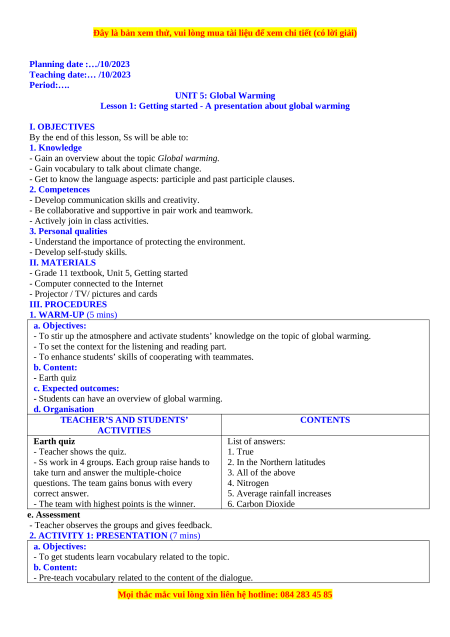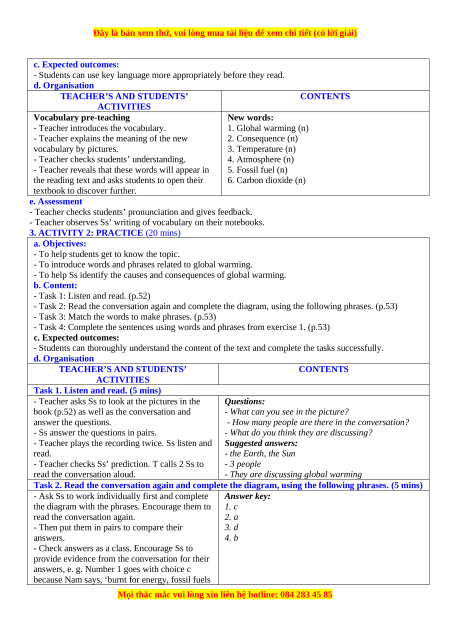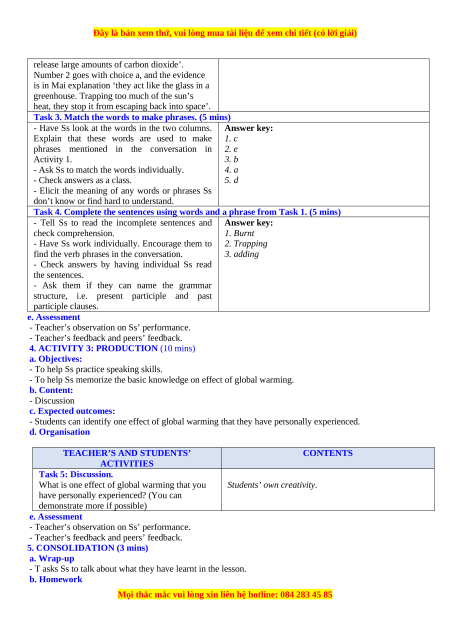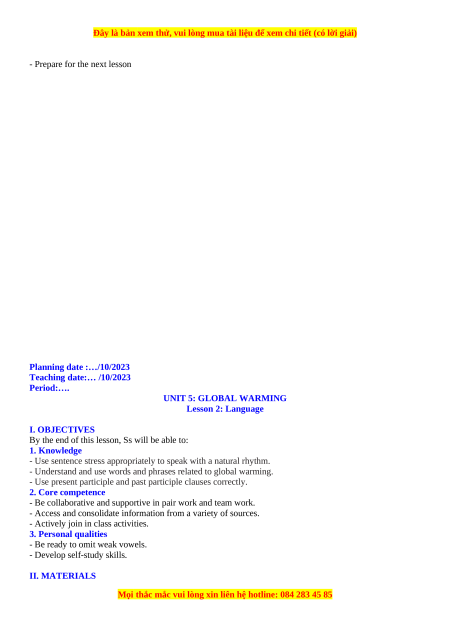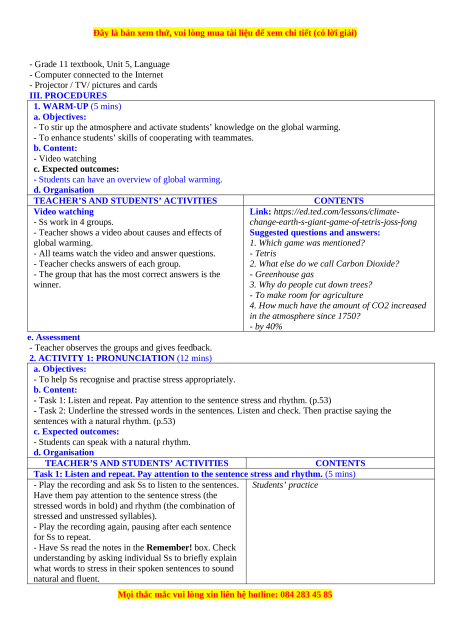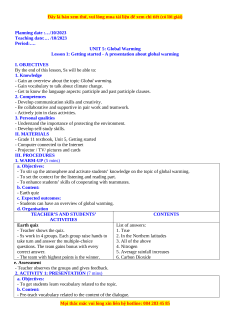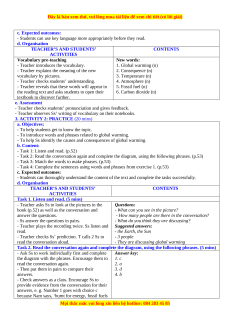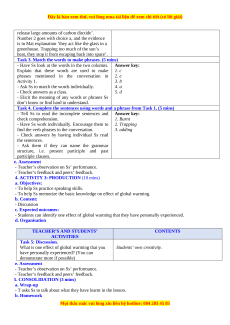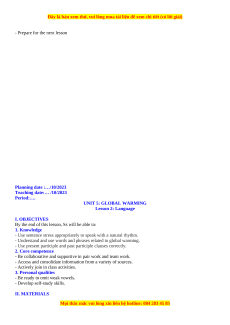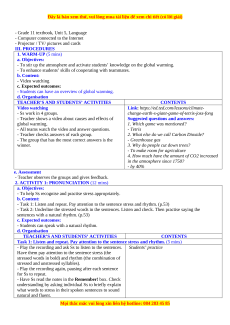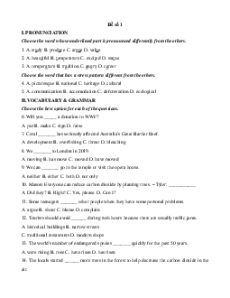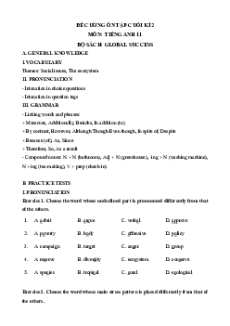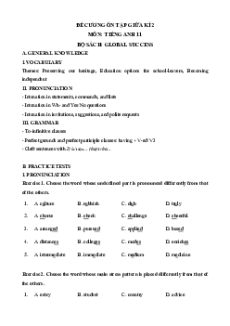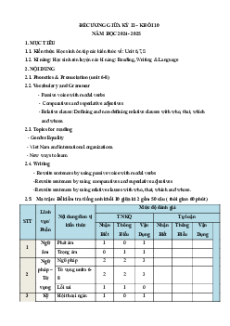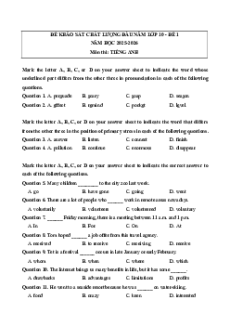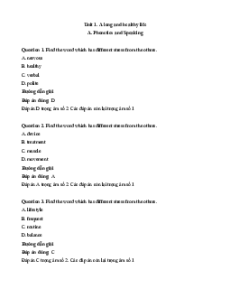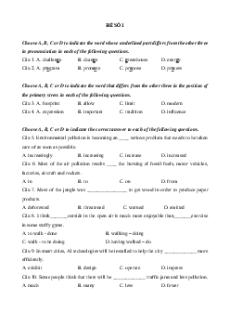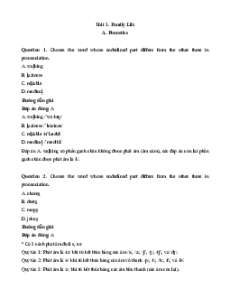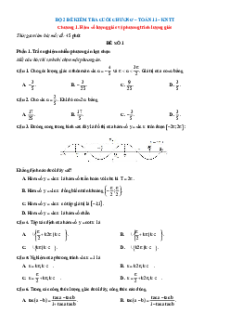Planning date :…/10/2023 Teaching date:… /10/2023 Period:…. UNIT 5: Global Warming
Lesson 1: Getting started - A presentation about global warming I. OBJECTIVES
By the end of this lesson, Ss will be able to: 1. Knowledge
- Gain an overview about the topic Global warming.
- Gain vocabulary to talk about climate change.
- Get to know the language aspects: participle and past participle clauses. 2. Competences
- Develop communication skills and creativity.
- Be collaborative and supportive in pair work and teamwork.
- Actively join in class activities. 3. Personal qualities
- Understand the importance of protecting the environment. - Develop self-study skills. II. MATERIALS
- Grade 11 textbook, Unit 5, Getting started
- Computer connected to the Internet
- Projector / TV/ pictures and cards III. PROCEDURES 1. WARM-UP (5 mins) a. Objectives:
- To stir up the atmosphere and activate students’ knowledge on the topic of global warming.
- To set the context for the listening and reading part.
- To enhance students’ skills of cooperating with teammates. b. Content: - Earth quiz c. Expected outcomes:
- Students can have an overview of global warming. d. Organisation
TEACHER’S AND STUDENTS’ CONTENTS ACTIVITIES Earth quiz List of answers: - Teacher shows the quiz. 1. True
- Ss work in 4 groups. Each group raise hands to 2. In the Northern latitudes
take turn and answer the multiple-choice 3. All of the above
questions. The team gains bonus with every 4. Nitrogen correct answer. 5. Average rainfall increases
- The team with highest points is the winner. 6. Carbon Dioxide e. Assessment
- Teacher observes the groups and gives feedback.
2. ACTIVITY 1: PRESENTATION (7 mins) a. Objectives:
- To get students learn vocabulary related to the topic. b. Content:
- Pre-teach vocabulary related to the content of the dialogue.
c. Expected outcomes:
- Students can use key language more appropriately before they read. d. Organisation
TEACHER’S AND STUDENTS’ CONTENTS ACTIVITIES Vocabulary pre-teaching New words:
- Teacher introduces the vocabulary. 1. Global warming (n)
- Teacher explains the meaning of the new 2. Consequence (n) vocabulary by pictures. 3. Temperature (n)
- Teacher checks students’ understanding. 4. Atmosphere (n)
- Teacher reveals that these words will appear in 5. Fossil fuel (n)
the reading text and asks students to open their 6. Carbon dioxide (n) textbook to discover further. e. Assessment
- Teacher checks students’ pronunciation and gives feedback.
- Teacher observes Ss’ writing of vocabulary on their notebooks.
3. ACTIVITY 2: PRACTICE (20 mins) a. Objectives:
- To help students get to know the topic.
- To introduce words and phrases related to global warming.
- To help Ss identify the causes and consequences of global warming. b. Content:
- Task 1: Listen and read. (p.52)
- Task 2: Read the conversation again and complete the diagram, using the following phrases. (p.53)
- Task 3: Match the words to make phrases. (p.53)
- Task 4: Complete the sentences using words and phrases from exercise 1. (p.53) c. Expected outcomes:
- Students can thoroughly understand the content of the text and complete the tasks successfully. d. Organisation
TEACHER’S AND STUDENTS’ CONTENTS ACTIVITIES
Task 1. Listen and read. (5 mins)
- Teacher asks Ss to look at the pictures in the Questions:
book (p.52) as well as the conversation and
- What can you see in the picture? answer the questions.
- How many people are there in the conversation?
- Ss answer the questions in pairs.
- What do you think they are discussing?
- Teacher plays the recording twice. Ss listen and
Suggested answers: read. - the Earth, the Sun
- Teacher checks Ss’ prediction. T calls 2 Ss to - 3 people read the conversation aloud.
- They are discussing global warming
Task 2. Read the conversation again and complete the diagram, using the following phrases. (5 mins)
- Ask Ss to work individually first and complete Answer key:
the diagram with the phrases. Encourage them to 1. c read the conversation again. 2. a
- Then put them in pairs to compare their 3. d answers. 4. b
- Check answers as a class. Encourage Ss to
provide evidence from the conversation for their
answers, e. g. Number 1 goes with choice c
because Nam says, ‘burnt for energy, fossil fuels
release large amounts of carbon dioxide’.
Number 2 goes with choice a, and the evidence
is in Mai explanation ‘they act like the glass in a
greenhouse. Trapping too much of the sun’s
heat, they stop it from escaping back into space’.
Task 3. Match the words to make phrases. (5 mins)
- Have Ss look at the words in the two columns. Answer key:
Explain that these words are used to make 1. c
phrases mentioned in the conversation in 2. e Activity 1. 3. b
- Ask Ss to match the words individually. 4. a - Check answers as a class. 5. d
- Elicit the meaning of any words or phrases Ss
don’t know or find hard to understand.
Task 4. Complete the sentences using words and a phrase from Task 1. (5 mins)
- Tell Ss to read the incomplete sentences and Answer key: check comprehension. 1. Burnt
- Have Ss work individually. Encourage them to 2. Trapping
find the verb phrases in the conversation. 3. adding
- Check answers by having individual Ss read the sentences.
- Ask them if they can name the grammar
structure, i.e. present participle and past participle clauses. e. Assessment
- Teacher’s observation on Ss’ performance.
- Teacher’s feedback and peers’ feedback.
4. ACTIVITY 3: PRODUCTION (10 mins) a. Objectives:
- To help Ss practice speaking skills.
- To help Ss memorize the basic knowledge on effect of global warming. b. Content: - Discussion c. Expected outcomes:
- Students can identify one effect of global warming that they have personally experienced. d. Organisation
TEACHER’S AND STUDENTS’ CONTENTS ACTIVITIES Task 5: Discussion.
What is one effect of global warming that you
Students’ own creativity.
have personally experienced? (You can demonstrate more if possible) e. Assessment
- Teacher’s observation on Ss’ performance.
- Teacher’s feedback and peers’ feedback.
5. CONSOLIDATION (3 mins) a. Wrap-up
- T asks Ss to talk about what they have learnt in the lesson. b. Homework
- Prepare for the next lesson Planning date :…/10/2023 Teaching date:… /10/2023 Period:…. UNIT 5: GLOBAL WARMING Lesson 2: Language I. OBJECTIVES
By the end of this lesson, Ss will be able to: 1. Knowledge
- Use sentence stress appropriately to speak with a natural rhythm.
- Understand and use words and phrases related to global warming.
- Use present participle and past participle clauses correctly. 2. Core competence
- Be collaborative and supportive in pair work and team work.
- Access and consolidate information from a variety of sources.
- Actively join in class activities. 3. Personal qualities
- Be ready to omit weak vowels. - Develop self-study skills. II. MATERIALS
Giáo án Unit 5: Global warming Tiếng Anh 11 Global success
1.7 K
866 lượt tải
MUA NGAY ĐỂ XEM TOÀN BỘ TÀI LIỆU
CÁCH MUA:
- B1: Gửi phí vào TK:
1133836868- CT TNHH DAU TU VA DV GD VIETJACK - Ngân hàng MB (QR) - B2: Nhắn tin tới Zalo VietJack Official ( nhấn vào đây ) để xác nhận thanh toán và tải tài liệu - giáo án
Liên hệ ngay Hotline hỗ trợ: 084 283 45 85
Bộ giáo án Tiếng Anh 11 Global success được cập nhật liên tục trong gói này từ nay đến hết tháng 3/2024.
Để tải tài liệu gốc về máy bạn click vào nút Tải Xuống ở trên!
Thuộc bộ (mua theo bộ để tiết kiệm hơn):
- Bộ giáo án Tiếng Anh 11 Global success năm 2023 kèm mô tả ma trận đề kiểm tra và kế hoạch giảng dạy mới, chuẩn nhất được thiết kế theo phong cách hiện đại, đẹp mắt, trình bày chi tiết cho từng bài học và bám sát chương trình Sách giáo khoa Tiếng Anh 11 Kết nối tri thức.
- Mua trọn bộ sẽ tiết kiệm hơn tải lẻ 50%.
Đánh giá
4.6 / 5(1731 )5
4
3
2
1
Trọng Bình
Tài liệu hay
Giúp ích cho tôi rất nhiều
Duy Trần
Tài liệu chuẩn
Rất thích tài liệu bên VJ soạn (bám sát chương trình dạy)
TÀI LIỆU BỘ BÁN CHẠY MÔN Tiếng Anh
Xem thêmTÀI LIỆU BỘ BÁN CHẠY Lớp 11
Xem thêmTài liệu bộ mới nhất

Đây là bản xem thử, vui lòng mua tài liệu để xem chi tiết (có lời giải)
Planning date :…/10/2023
Teaching date:… /10/2023
Period:….
UNIT 5: Global Warming
Lesson 1: Getting started - A presentation about global warming
I. OBJECTIVES
By the end of this lesson, Ss will be able to:
1. Knowledge
- Gain an overview about the topic Global warming.
- Gain vocabulary to talk about climate change.
- Get to know the language aspects: participle and past participle clauses.
2. Competences
- Develop communication skills and creativity.
- Be collaborative and supportive in pair work and teamwork.
- Actively join in class activities.
3. Personal qualities
- Understand the importance of protecting the environment.
- Develop self-study skills.
II. MATERIALS
- Grade 11 textbook, Unit 5, Getting started
- Computer connected to the Internet
- Projector / TV/ pictures and cards
III. PROCEDURES
1. WARM-UP (5 mins)
a. Objectives:
- To stir up the atmosphere and activate students’ knowledge on the topic of global warming.
- To set the context for the listening and reading part.
- To enhance students’ skills of cooperating with teammates.
b. Content:
- Earth quiz
c. Expected outcomes:
- Students can have an overview of global warming.
d. Organisation
TEACHER’S AND STUDENTS’
ACTIVITIES
CONTENTS
Earth quiz
- Teacher shows the quiz.
- Ss work in 4 groups. Each group raise hands to
take turn and answer the multiple-choice
questions. The team gains bonus with every
correct answer.
- The team with highest points is the winner.
List of answers:
1. True
2. In the Northern latitudes
3. All of the above
4. Nitrogen
5. Average rainfall increases
6. Carbon Dioxide
e. Assessment
- Teacher observes the groups and gives feedback.
2. ACTIVITY 1: PRESENTATION (7 mins)
a. Objectives:
- To get students learn vocabulary related to the topic.
b. Content:
- Pre-teach vocabulary related to the content of the dialogue.
Mọi thắc mắc vui lòng xin liên hệ hotline: 084 283 45 85

Đây là bản xem thử, vui lòng mua tài liệu để xem chi tiết (có lời giải)
c. Expected outcomes:
- Students can use key language more appropriately before they read.
d. Organisation
TEACHER’S AND STUDENTS’
ACTIVITIES
CONTENTS
Vocabulary pre-teaching
- Teacher introduces the vocabulary.
- Teacher explains the meaning of the new
vocabulary by pictures.
- Teacher checks students’ understanding.
- Teacher reveals that these words will appear in
the reading text and asks students to open their
textbook to discover further.
New words:
1. Global warming (n)
2. Consequence (n)
3. Temperature (n)
4. Atmosphere (n)
5. Fossil fuel (n)
6. Carbon dioxide (n)
e. Assessment
- Teacher checks students’ pronunciation and gives feedback.
- Teacher observes Ss’ writing of vocabulary on their notebooks.
3. ACTIVITY 2: PRACTICE (20 mins)
a. Objectives:
- To help students get to know the topic.
- To introduce words and phrases related to global warming.
- To help Ss identify the causes and consequences of global warming.
b. Content:
- Task 1: Listen and read. (p.52)
- Task 2: Read the conversation again and complete the diagram, using the following phrases. (p.53)
- Task 3: Match the words to make phrases. (p.53)
- Task 4: Complete the sentences using words and phrases from exercise 1. (p.53)
c. Expected outcomes:
- Students can thoroughly understand the content of the text and complete the tasks successfully.
d. Organisation
TEACHER’S AND STUDENTS’
ACTIVITIES
CONTENTS
Task 1. Listen and read. (5 mins)
- Teacher asks Ss to look at the pictures in the
book (p.52) as well as the conversation and
answer the questions.
- Ss answer the questions in pairs.
- Teacher plays the recording twice. Ss listen and
read.
- Teacher checks Ss’ prediction. T calls 2 Ss to
read the conversation aloud.
Questions:
- What can you see in the picture?
- How many people are there in the conversation?
- What do you think they are discussing?
Suggested answers:
- the Earth, the Sun
- 3 people
- They are discussing global warming
Task 2. Read the conversation again and complete the diagram, using the following phrases. (5 mins)
- Ask Ss to work individually first and complete
the diagram with the phrases. Encourage them to
read the conversation again.
- Then put them in pairs to compare their
answers.
- Check answers as a class. Encourage Ss to
provide evidence from the conversation for their
answers, e. g. Number 1 goes with choice c
because Nam says, ‘burnt for energy, fossil fuels
Answer key:
1. c
2. a
3. d
4. b
Mọi thắc mắc vui lòng xin liên hệ hotline: 084 283 45 85

Đây là bản xem thử, vui lòng mua tài liệu để xem chi tiết (có lời giải)
release large amounts of carbon dioxide’.
Number 2 goes with choice a, and the evidence
is in Mai explanation ‘they act like the glass in a
greenhouse. Trapping too much of the sun’s
heat, they stop it from escaping back into space’.
Task 3. Match the words to make phrases. (5 mins)
- Have Ss look at the words in the two columns.
Explain that these words are used to make
phrases mentioned in the conversation in
Activity 1.
- Ask Ss to match the words individually.
- Check answers as a class.
- Elicit the meaning of any words or phrases Ss
don’t know or find hard to understand.
Answer key:
1. c
2. e
3. b
4. a
5. d
Task 4. Complete the sentences using words and a phrase from Task 1. (5 mins)
- Tell Ss to read the incomplete sentences and
check comprehension.
- Have Ss work individually. Encourage them to
find the verb phrases in the conversation.
- Check answers by having individual Ss read
the sentences.
- Ask them if they can name the grammar
structure, i.e. present participle and past
participle clauses.
Answer key:
1. Burnt
2. Trapping
3. adding
e. Assessment
- Teacher’s observation on Ss’ performance.
- Teacher’s feedback and peers’ feedback.
4. ACTIVITY 3: PRODUCTION (10 mins)
a. Objectives:
- To help Ss practice speaking skills.
- To help Ss memorize the basic knowledge on effect of global warming.
b. Content:
- Discussion
c. Expected outcomes:
- Students can identify one effect of global warming that they have personally experienced.
d. Organisation
TEACHER’S AND STUDENTS’
ACTIVITIES
CONTENTS
Task 5: Discussion.
What is one effect of global warming that you
have personally experienced? (You can
demonstrate more if possible)
Students’ own creativity.
e. Assessment
- Teacher’s observation on Ss’ performance.
- Teacher’s feedback and peers’ feedback.
5. CONSOLIDATION (3 mins)
a. Wrap-up
- T asks Ss to talk about what they have learnt in the lesson.
b. Homework
Mọi thắc mắc vui lòng xin liên hệ hotline: 084 283 45 85

Đây là bản xem thử, vui lòng mua tài liệu để xem chi tiết (có lời giải)
- Prepare for the next lesson
Planning date :…/10/2023
Teaching date:… /10/2023
Period:….
UNIT 5: GLOBAL WARMING
Lesson 2: Language
I. OBJECTIVES
By the end of this lesson, Ss will be able to:
1. Knowledge
- Use sentence stress appropriately to speak with a natural rhythm.
- Understand and use words and phrases related to global warming.
- Use present participle and past participle clauses correctly.
2. Core competence
- Be collaborative and supportive in pair work and team work.
- Access and consolidate information from a variety of sources.
- Actively join in class activities.
3. Personal qualities
- Be ready to omit weak vowels.
- Develop self-study skills.
II. MATERIALS
Mọi thắc mắc vui lòng xin liên hệ hotline: 084 283 45 85

Đây là bản xem thử, vui lòng mua tài liệu để xem chi tiết (có lời giải)
- Grade 11 textbook, Unit 5, Language
- Computer connected to the Internet
- Projector / TV/ pictures and cards
III. PROCEDURES
1. WARM-UP (5 mins)
a. Objectives:
- To stir up the atmosphere and activate students’ knowledge on the global warming.
- To enhance students’ skills of cooperating with teammates.
b. Content:
- Video watching
c. Expected outcomes:
- Students can have an overview of global warming.
d. Organisation
TEACHER’S AND STUDENTS’ ACTIVITIES CONTENTS
Video watching
- Ss work in 4 groups.
- Teacher shows a video about causes and effects of
global warming.
- All teams watch the video and answer questions.
- Teacher checks answers of each group.
- The group that has the most correct answers is the
winner.
Link: https://ed.ted.com/lessons/climate-
change-earth-s-giant-game-of-tetris-joss-fong
Suggested questions and answers:
1. Which game was mentioned?
- Tetris
2. What else do we call Carbon Dioxide?
- Greenhouse gas
3. Why do people cut down trees?
- To make room for agriculture
4. How much have the amount of CO2 increased
in the atmosphere since 1750?
- by 40%
e. Assessment
- Teacher observes the groups and gives feedback.
2. ACTIVITY 1: PRONUNCIATION (12 mins)
a. Objectives:
- To help Ss recognise and practise stress appropriately.
b. Content:
- Task 1: Listen and repeat. Pay attention to the sentence stress and rhythm. (p.53)
- Task 2: Underline the stressed words in the sentences. Listen and check. Then practise saying the
sentences with a natural rhythm. (p.53)
c. Expected outcomes:
- Students can speak with a natural rhythm.
d. Organisation
TEACHER’S AND STUDENTS’ ACTIVITIES CONTENTS
Task 1: Listen and repeat. Pay attention to the sentence stress and rhythm. (5 mins)
- Play the recording and ask Ss to listen to the sentences.
Have them pay attention to the sentence stress (the
stressed words in bold) and rhythm (the combination of
stressed and unstressed syllables).
- Play the recording again, pausing after each sentence
for Ss to repeat.
- Have Ss read the notes in the Remember! box. Check
understanding by asking individual Ss to briefly explain
what words to stress in their spoken sentences to sound
natural and fluent.
Students’ practice
Mọi thắc mắc vui lòng xin liên hệ hotline: 084 283 45 85
